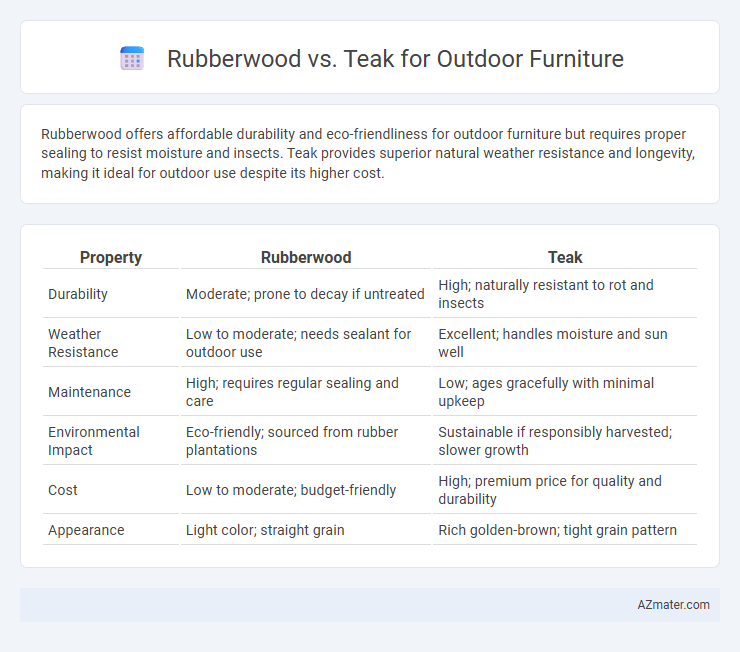Rubberwood offers affordable durability and eco-friendliness for outdoor furniture but requires proper sealing to resist moisture and insects. Teak provides superior natural weather resistance and longevity, making it ideal for outdoor use despite its higher cost.
Table of Comparison
| Property | Rubberwood | Teak |
|---|---|---|
| Durability | Moderate; prone to decay if untreated | High; naturally resistant to rot and insects |
| Weather Resistance | Low to moderate; needs sealant for outdoor use | Excellent; handles moisture and sun well |
| Maintenance | High; requires regular sealing and care | Low; ages gracefully with minimal upkeep |
| Environmental Impact | Eco-friendly; sourced from rubber plantations | Sustainable if responsibly harvested; slower growth |
| Cost | Low to moderate; budget-friendly | High; premium price for quality and durability |
| Appearance | Light color; straight grain | Rich golden-brown; tight grain pattern |
Introduction: Rubberwood vs Teak for Outdoor Furniture
Rubberwood offers a sustainable and affordable choice for outdoor furniture, known for its light color, moderate durability, and resistance to pests when properly treated. Teak stands out for its exceptional natural oils and dense grain, providing superior weather resistance, longevity, and minimal maintenance in outdoor environments. Comparing Rubberwood and Teak highlights key factors such as durability, cost, and environmental impact essential for selecting the best material for outdoor furniture.
Overview of Rubberwood and Teak
Rubberwood, sourced from the Para rubber tree (Hevea brasiliensis), is a sustainable and affordable hardwood known for its light color and fine grain, making it a popular choice for outdoor furniture due to its durability and resistance to fungal attacks when properly treated. Teak, derived from the Tectona grandis tree native to Southeast Asia, is highly prized for its natural oils and dense grain, which provide exceptional resistance to water, insects, and decay without much maintenance. Both woods offer unique advantages for outdoor use, with rubberwood excelling in eco-friendliness and cost-effectiveness, while teak delivers premium longevity and weather resistance.
Durability and Weather Resistance
Rubberwood offers moderate durability and performs well in dry outdoor environments but is susceptible to moisture damage and requires protective finishes for preventing rot and insect infestation. Teak is highly durable with natural oils that provide superior resistance to weather, moisture, insects, and decay, making it ideal for long-lasting outdoor furniture under various climatic conditions. While teak demands less maintenance due to its weather-resistant properties, rubberwood's affordability makes it a practical choice if treated and sheltered properly.
Maintenance Requirements
Rubberwood requires regular sealing and protective coatings to prevent moisture damage and prolong its lifespan outdoors, while teak naturally contains oils that resist water, insects, and decay, reducing maintenance efforts. Although teak ages gracefully with minimal care, rubberwood demands consistent treatment with linseed oil or varnish to maintain durability and appearance under varying weather conditions. Choosing teak often results in lower long-term maintenance costs compared to the frequent upkeep needed for rubberwood in outdoor furniture applications.
Appearance and Aesthetic Appeal
Rubberwood features a pale blond color with a straight grain that offers a smooth, consistent appearance ideal for contemporary outdoor furniture designs. Teak boasts a rich golden-brown hue that deepens with age, exhibiting a natural luster and distinctive grain patterns highly prized for classic and luxurious outdoor settings. Both woods provide unique aesthetic appeals, with teak delivering superior elegance and natural weathering qualities while rubberwood offers versatility and a cost-effective alternative with a clean, understated look.
Sustainability and Environmental Impact
Rubberwood and teak differ significantly in sustainability and environmental impact for outdoor furniture. Rubberwood is eco-friendly, sourced from rubber trees at the end of their latex-producing cycle, reducing waste and promoting reforestation. Teak, although durable and naturally resistant to decay, faces challenges due to slower growth rates and overharvesting, often requiring certification like FSC to ensure responsible sourcing.
Cost Comparison
Rubberwood offers a cost-effective alternative to teak for outdoor furniture, with prices typically 30-50% lower due to its abundant availability and faster growth cycle. Teak, prized for its natural oils and durability, commands a premium price often two to three times higher than rubberwood, reflecting its longevity and resistance to weathering. Choosing rubberwood enables budget-conscious buyers to achieve stylish outdoor setups without sacrificing quality, while teak remains a long-term investment for superior resilience and minimal maintenance.
Suitability for Outdoor Use
Rubberwood offers moderate durability and resistance to moisture, making it suitable for covered outdoor areas but requiring regular treatment to prevent weather damage. Teak's natural oils provide exceptional resistance to water, insects, and decay, establishing it as a superior choice for exposed outdoor furniture without extensive maintenance. Both woods benefit from protective finishes, but teak's inherent properties ensure longer-lasting performance in various outdoor environments.
Pros and Cons of Rubberwood Outdoor Furniture
Rubberwood outdoor furniture offers affordability, eco-friendliness, and a smooth finish that resists warping, making it a sustainable choice for garden settings. However, its durability is lower than teak, and it requires regular sealing or protective coatings to withstand moisture and insect damage. While rubberwood is susceptible to fading and may need more maintenance, it provides an economical alternative with decent strength for light to moderate outdoor use.
Pros and Cons of Teak Outdoor Furniture
Teak outdoor furniture boasts exceptional durability and natural resistance to moisture, insects, and decay, making it ideal for long-lasting use in various weather conditions. Its high oil content helps maintain structural integrity and a beautiful patina without requiring extensive maintenance, though periodic oiling can enhance its golden hue. The primary drawback of teak is its higher cost compared to other woods like rubberwood, and improper sealing may lead to surface cracks or graying over time.

Infographic: Rubberwood vs Teak for Outdoor Furniture
 azmater.com
azmater.com